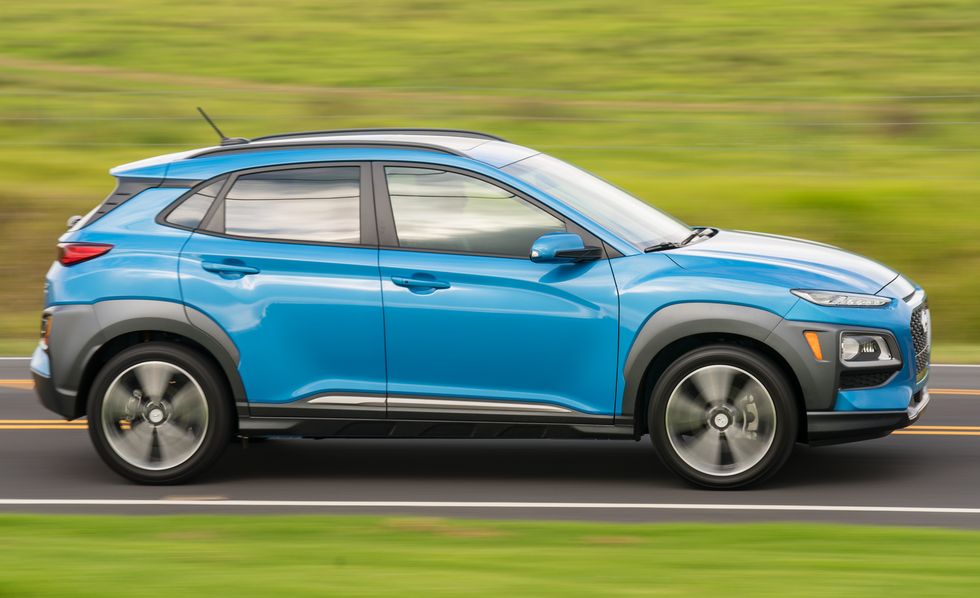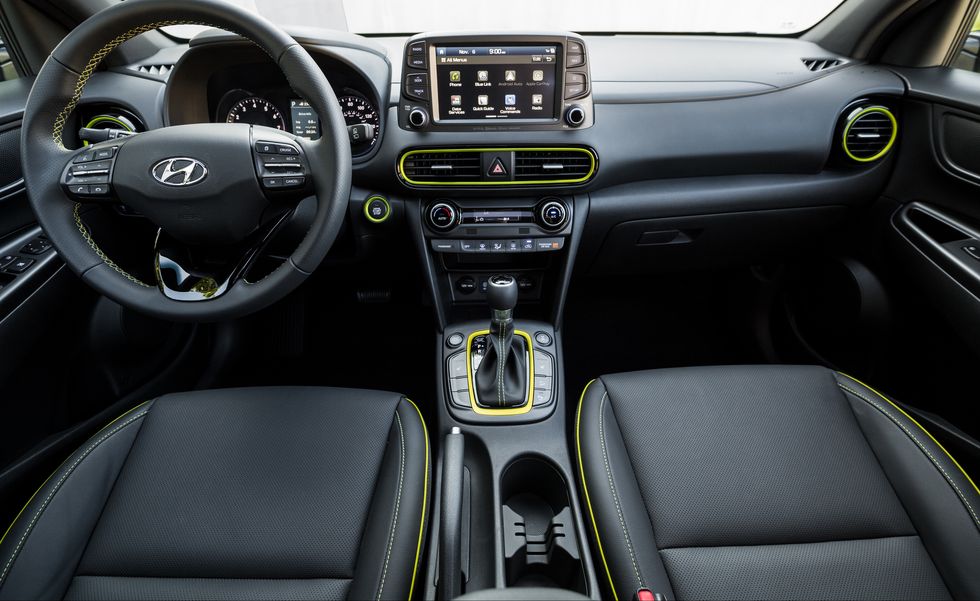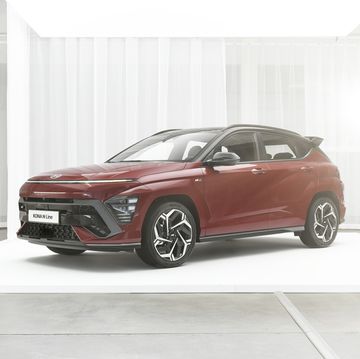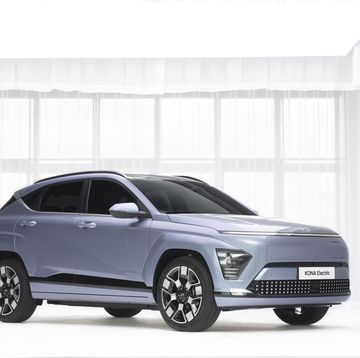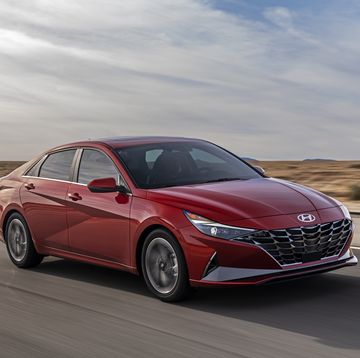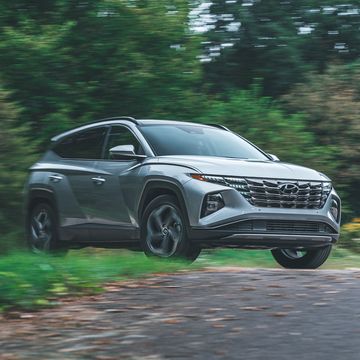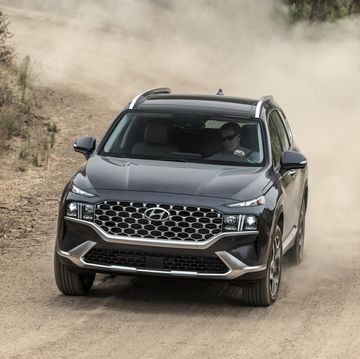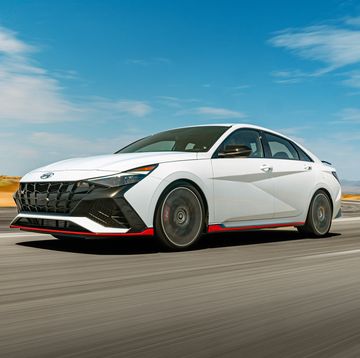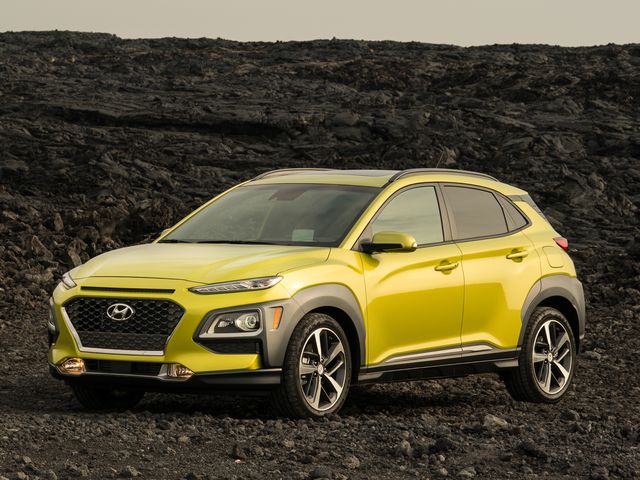
Select a year
- Highs Standout styling, punchy turbo four, packed with features.
- Lows Tight cargo space, numb steering.
- Verdict Intrigues with adventurous styling, seals the deal with driving enjoyment.
Overview
The subcompact Hyundai Kona is the whole package: Striking looks, engaging driving dynamics, and a comfortable cabin. We like it so much we put it on our 2019 10Best list. A pair of four-cylinder engines are available, the best of which is the turbocharged 1.6-liter that provides brisk acceleration and good fuel economy. Its exterior turns heads, even two years after its introduction, but its cabin is more muted and feels grownup in both its design and execution. Cargo space will be adequate for most buyers but those seeking space for bulky items may be better served by one of the Kona's slightly larger rivals.
What's New for 2020?
A few high-end features trickle down to the new mid-range SEL Plus model for 2020. Previously only available on the top-spec Ultimate, the SEL Plus comes with a 4.2-inch color display located between the two analog gauges and a wireless charging pad for smartphones. The auto-dimming rearview mirror with HomeLink is now standard on both the Limited and Ultimate models as well as a new orange interior accent kit that automatically is added to either trim if the Sunset Orange or Ultra Black exterior colors are chosen. Adaptive cruise control also joins the spec sheet but is exclusive to the Ultimate model; last year's limited Iron Man Edition model has been discontinued.
Pricing and Which One to Buy
If it were our money, we'd spring for the nearly loaded Limited model, as it offers nearly all of the most sought-after equipment without being too expensive. Standard equipment includes a sunroof, automatic climate control, fog lamps, leather upholstery, and a power-adjustable driver's seat. Going with the Limited also gives us the spunky turbocharged four-cylinder engine and exterior styling that mimics that of the top-spec Ultimate model, so no one will know you saved the extra cash. The prices above are for front-wheel-drive variants; all-wheel-drive models cost $1400 more.
Engine, Transmission, and Performance
Two powertrains are available with the Kona: SE and SEL models come with a 147-hp four-cylinder and a six-speed automatic transmission. This setup could use a bit of caffeine; in our testing, an all-wheel-drive SEL model required 9.2 seconds to reach 60 mph. Limited and Ultimate models are powered by the considerably peppier 175-hp turbocharged four-cylinder paired to a seven-speed dual-clutch automatic. With the turbo four, the Kona scampered from zero to 60 mph in 6.6 seconds, just 0.1 second behind the rapid Kia Soul Exclaim. The seven-speed dual-clutch automatic shifts quickly and smoothly once you're rolling, but it stumbles at low speed in parking lots and in bumper-to-bumper traffic, engaging and disengaging first gear hesitantly until the driver offers more throttle input. The Kona delivers agile handling and a surprising amount of fun. This doesn't translate to a rough ride over choppy roads; in fact, the suspension offers quite the opposite, damping out bumps and providing occupants with a cabin that is well isolated from pavement imperfections. The steering is perhaps the Kona's biggest dynamic downfall: it's an uncommunicative helm that requires frequent corrections when cruising the highway despite its heavy-weighted feel.
Fuel Economy and Real-World MPG
In this class of fuel-sipping mini SUVs, the Kona's EPA ratings are good but only average among its rivals. Despite this, the Kona impressed us during our real-world testing, besting much of its competition. With the turbocharged engine under the hood, the Kona delivered 32 mpg in our 200-mile highway fuel-economy test; we managed 33 mpg with the base four-cylinder.
Interior, Comfort, and Cargo
Hyundai's designers managed the tough task of bringing the charm of the Kona's exterior design to the cabin while maintaining comfort and convenience. Quality materials, good ergonomics, and comfortable seats feel grown up and refined but not out of step with the Kona's funkadelic outward appearance. The driver faces a pair of simple analog gauges framing a slim digital readout; the steering wheel is wrapped with a nicely grained leather with contrast stitching and offers integrated controls for cruise control and audio settings. Those upgrading from a compact hatchback or sedan will find the Kona's cargo space perfectly suitable, but buyers downsizing from a larger SUV will most likely feel the pinch. The Kona narrowly beat the pipsqueak Mazda CX-3 in our testing to see how many carry-on suitcases could fit. The Kona managed to hold 14 of our carry-on suitcases—two more than the CX-3 but eight fewer than the Honda HR-V.
Infotainment and Connectivity
Standing atop the Kona's dashboard is a touchscreen infotainment system flanked by simple shortcut buttons that allow you to easily switch between common menus. We found the system to be intuitive in its operation but leisurely when responding to inputs. The SE, SEL, and Limited trims come with the smaller, standard 7.0-inch touchscreen, but buyers of the Ultimate model are treated to the larger 8.0-inch unit that also features navigation with real-time traffic updates. Driving directions can be projected onto the Ultimate's head-up display that flips up from the dashboard and also shows the vehicle's speed and other information. Apple CarPlay and Android Auto capability are standard, so buyers of one of the three lower trims can still access turn-by-turn directions from their smartphones.
Safety and Driver-Assistance Features
The National Highway Traffic Safety Administration (NHTSA) has given the Kona a five-star safety rating and the Insurance Institute for Highway Safety (IIHS) has named it a Top Safety Pick+. Buyers searching for popular driver-assistance features will find them on the Kona, which offers automated emergency braking, lane-keeping assist, and a driver-attention monitor as standard equipment. Other more advanced features are still optional. Key safety features include:
- Standard automated emergency braking
- Standard lane-keeping warning
- Available automatic high-beam headlamps
Warranty and Maintenance Coverage
By now, Hyundai's 10-year powertrain warranty is well known in the automotive industry as being one of the most generous policies available, and the Kona receives the same coverages as the rest of the lineup. The company also now offers complimentary scheduled maintenance that bests mainstream rivals such as Toyota.
- Limited warranty covers 5 years or 60,000 miles
- Powertrain warranty covers 10 years or 100,000 miles
- Complimentary maintenance covers 3 years or 36,000 miles
